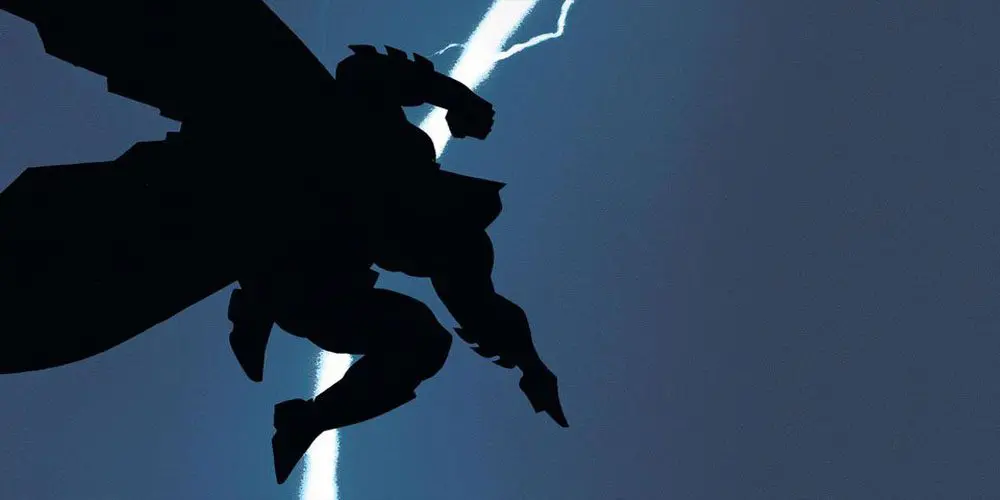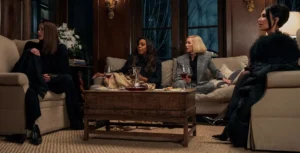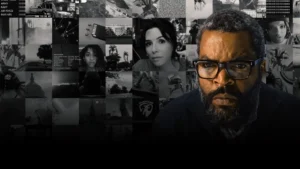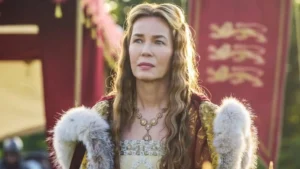Summary
Part 1 of Frank Miller’s iconic The Dark Knight Returns sets the highest standard yet for DC’s animated fare, delivering an important and highly cinematic treatment of the iconic material.
Batman: The Dark Knight Returns, Part 1 is a DC Universe Animated Original Movie. Check out the full archive by clicking these words.
Batman: The Dark Knight Returns, Part 1 is another delve into the addled imagination of Frank Miller, whose definitive Batman origin story, Year One, I recently declared one of the worst adaptations to yet be churned out by DC’s generally-excellent collaboration with Warner Bros.
Well… I guess we’re off to an awkward start.
Fear not, though, because Miller didn’t just reimagine Batman’s beginning, but also his end; The Dark Knight Returns is another iconic, seminal work in Batman’s long and storied history, and the first part of it, directed by Jay Oliva and adapted for the screen by Bob Goodman, is easily the best Batman story since Under the Red Hood, and stands alongside that movie, Wonder Woman, and Superman vs. The Elite as some of the best superheroic shenanigans yet committed to film.
It seems that the original story’s vaunted place in the comic-book pantheon didn’t lend itself well to an abridgment. For the first time, instead of trying to compress a multi-issue arc into a single, short movie, DC and Warner have taken the scalpel to the source material and delivered two feature-length halves of Miller’s four-part classic.
READ: 10 Best DC Animated Movies you must watch
Part 1 is about Batman being old, basically. Now fifty-five and forcibly retired by a national crackdown on vigilante justice, Bruce Wayne (Peter Weller), a square-jawed, liquor-soaked slab of muscle, is forced to sit idly by as Gotham City again circles the drain of the criminal underworld. Old foes are back in business, Commissioner Gordon (David Selby) is due to retire, and a new group of street-punks led by a messianic behemoth is running rampantly unchecked; until, of course, Batman dons the cape one last time in order to punch everyone in the face.
This certainly sounds like a Batman story. Correction: It sounds like the Batman story.
Let it never be understated how integral The Dark Knight Returns is to our cultural understanding and appreciation of Batman. Miller’s late-80s work on the character didn’t just defibrillate one of DC’s flagship heroes, but most of the comic-book industry. Oliva and Goodman recognize this by adhering rigidly to the original comic, and, for once, given the additional leg-room, that’s a smart creative decision. A lot of Miller’s work here was intended to look like pulpy, poetic film noir, and now that it moves, it feels like that, too. The stuff that didn’t make the cut – most notably Batman’s stream-of-consciousness narration – is papered over by other aspects suddenly working much better in motion; the previously-static news broadcasts deliver the thematic and expositional context better than a voice-over could, and they easily navigate the audience through plot developments while keeping the complexity intact.
The movie takes great pleasure in satirizing various news media and debate show personalities, in particular, Michael McKean’s Dr. Bartholomew Wolper, a bleeding-heart psychiatrist who insists that Batman is a menace who inspires the crime he fights. But the broader purpose of these interstitials is to provide a platform for peripheral characters to ruminate on Batman as an icon, a symbol, rather than just an old dude checking if his clothes still fit.
There are certainly aspects of The Dark Knight Returns that have been softened in Part 1, but when the essential nature of a story is to present Batman as a borderline-psychotic obsessive, there’s only so much you can do to make it broadly accessible. Any concessions that have been made feel in service of adapting to a new form rather than making the material more palatable; Miller’s angry, scribbly artwork doesn’t translate well to animation, so while the concepts and designs are retained, it’s married to a more exact, high-quality visual style. And that’s fine. It allows the story’s iconic panels to be expertly animated, but it doesn’t let the material escape from the oppressive, vaguely apocalyptic weight of the original’s overwhelming 80s mood.
In this case, the mood is everything. It’s largely seen as something of a joke these days – a disgruntled Batman running around a retro-future Gotham City, being angry and punching people. It has been imitated so many times since this story was first published that the idea of a Slightly Lighter Knight is something people long for as though it never existed in the first place. But Miller’s work here and in Year One turned off the lights in Batman storytelling, and people embraced it because it felt like such a radical reimagining of an iconic character. You can’t do away with the grit and grime because it has become retroactively clichéd; it’s intrinsic to how the work feels and functions. Besides, imagine Miller’s hardboiled dialogue in a frothy Justice League cartoon. It’d be embarrassing.
Oh, the voice acting. I can’t say that Peter Weller is the first name that crops into my mind when I think of Batman, but then again, if you need an actor to deliver sardonic lines about mutants, they might as well do it in a steady, confident monotone. There’s a gravelly quality to Weller’s Batman that really works, but it admittedly casts an awkward sideways glance at David Selby’s Commissioner Gordon; a thoroughly bizarre casting choice who lends the old-school career-cop a distractingly nasal whine.
Ariel Winter is a plucky choice for Carrie Kelley, the excitable girl scout who volunteers to be the next (and first female) Robin, and Gary Anthony Williams does a great job at giving the mutant leader – a one-dimensional villain – a believably threatening edge. It’s not a spectacular voice cast, but they’re reading through material that has dramatic significance baked-in; you get the sense that simply reading the lines would have been enough. An actual performance is almost a bonus.
As for the verdict, well, you tell me. You get the iconic tone, designs, and imagery; you get a satisfying quotient of crunchy Batman action and unique set-pieces; and you get the subtext, social commentary, and multi-layered character examination – all within the first half of the story. The Dark Knight Returns, Part 1 ends with two whole issues of Miller’s work still left to adapt, but even as things stand it feels like the most complete, cinematic work in DC’s animated line. Even if you’re slavishly devoted to the original book, this is mandatory viewing for anyone who enjoys compelling stories, whether they’re plucked from comics or anywhere else. It’d be selling it short to suggest otherwise.




